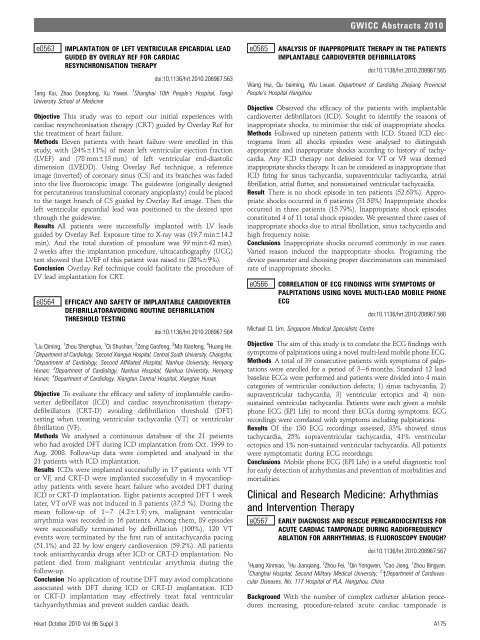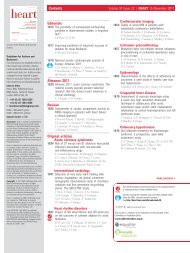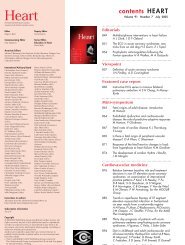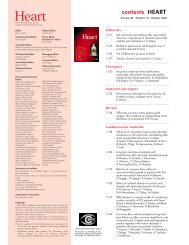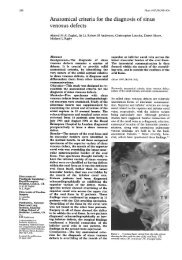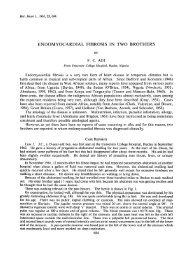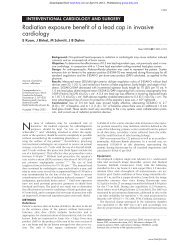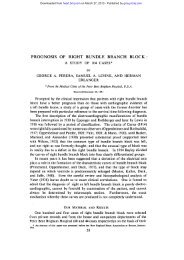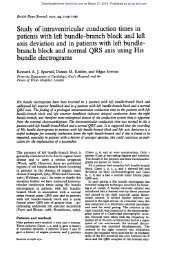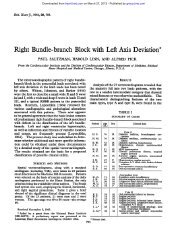A175 Clinical and Research Medicine - Heart
A175 Clinical and Research Medicine - Heart
A175 Clinical and Research Medicine - Heart
Create successful ePaper yourself
Turn your PDF publications into a flip-book with our unique Google optimized e-Paper software.
e0563 IMPLANTATION OF LEFT VENTRICULAR EPICARDIAL LEAD<br />
GUIDED BY OVERLAY REF FOR CARDIAC<br />
RESYNCHRONISATION THERAPY<br />
doi:10.1136/hrt.2010.208967.563<br />
Tang Kai, Zhao Dongdong, Xu Yawei. 1 Shanghai 10th People’s Hospital, Tongji<br />
University School of <strong>Medicine</strong><br />
Objective This study was to report our initial experiences with<br />
cardiac resynchronisation therapy (CRT) guided by Overlay Ref for<br />
the treatment of heart failure.<br />
Methods Eleven patients with heart failure were enrolled in this<br />
study, with (24%611%) of mean left ventricular ejection fraction<br />
(LVEF) <strong>and</strong> (78 mm613 mm) of left ventricular end-diastolic<br />
dimension (LVEDD). Using Overlay Ref technique, a reference<br />
image (inverted) of coronary sinus (CS) <strong>and</strong> its branches was faded<br />
into the live fluoroscopic image. The guidewire (originally designed<br />
for percutaneous transluminal coronary angioplasty) could be placed<br />
to the target branch of CS guided by Overlay Ref image. Then the<br />
left ventricular epicardial lead was positioned to the desired spot<br />
through the guidewire.<br />
Results All patients were successfully implanted with LV leads<br />
guided by Overlay Ref. Exposure time to X-ray was (19.7 min614.2<br />
min). And the total duration of procedure was 99 min642 min).<br />
2 weeks after the implantation procedure, ultracardiography (UCG)<br />
test showed that LVEF of this patient was raised to (28%69%).<br />
Conclusion Overlay Ref technique could facilitate the procedure of<br />
LV lead implantation for CRT.<br />
e0564 EFFICACY AND SAFETY OF IMPLANTABLE CARDIOVERTER<br />
DEFIBRILLATORAVOIDING ROUTINE DEFIBRILLATION<br />
THRESHOLD TESTING<br />
doi:10.1136/hrt.2010.208967.564<br />
1 Liu Qiming, 1 Zhou Shenghua, 1 Qi Shushan, 2 Zeng Gaofeng, 3 Ma Xiaofeng, 4 Huang He.<br />
1 Department of Cardiology, Second Xiangya Hospital, Central South University, Changsha;<br />
2 Department of Cardiology, Second Affiliated Hospital, Nanhua University, Henyang<br />
Hunan; 3 Department of Cardiology, Nanhua Hospital, Nanhua University, Henyang<br />
Hunan; 4 Department of Cardiology, Xiangtan Central Hospital, Xiangtan Hunan<br />
Objective To evaluate the efficacy <strong>and</strong> safety of implantable cardioverter<br />
defibrillator (ICD) <strong>and</strong> cardiac resynchronisation therapydefibrillators<br />
(CRT-D) avoiding defibrillation threshold (DFT)<br />
testing when treating ventricular tachycardia (VT) or ventricular<br />
fibrillation (VF).<br />
Methods We analysed a continuous database of the 21 patients<br />
who had avoided DFT during ICD implantation from Oct. 1999 to<br />
Aug. 2008. Follow-up data were completed <strong>and</strong> analysed in the<br />
21 patients with ICD implantation.<br />
Results ICDs were implanted successfully in 17 patients with VT<br />
or VF, <strong>and</strong> CRT-D were implanted successfully in 4 myocardiopathy<br />
patients with severe heart failure who avoided DFT during<br />
ICD or CRT-D implantation. Eight patients accepted DFT 1 week<br />
later, VT orVF was not induced in 3 patients (37.5 %). During the<br />
mean follow-up of 1e7 (4.261.9) yrs, malignant ventricular<br />
arrythmia was recorded in 16 patients. Among them, 89 episodes<br />
were successfully terminated by defbrillation (100%), 120 VT<br />
events were terminated by the first run of antitachycardia pacing<br />
(51.1%) <strong>and</strong> 22 by low engery cardioversion (59.2%). All patients<br />
took antiarrhycardia drugs after ICD or CRT-D implantation. No<br />
patient died from malignant ventricular arrythmia during the<br />
follow-up.<br />
Conclusion No application of routine DFT may aviod complications<br />
associated with DFT during ICD or CRT-D implantation. ICD<br />
or CRT-D implantation may effectively treat fatal ventricular<br />
tachyarrhythmias <strong>and</strong> prevent sudden cardiac death.<br />
e0565 ANALYSIS OF INAPPROPRIATE THERAPY IN THE PATIENTS<br />
IMPLANTABLE CARDIOVERTER DEFIBRILLATORS<br />
doi:10.1136/hrt.2010.208967.565<br />
Wang Hui, Qu baiming, Wu Lixuan. Department of Cardiolog Zhejiang Provincial<br />
People’s Hospital Hangzhou<br />
Objective Observed the efficacy of the patients with implantable<br />
cardioverter defibrillators (ICD). Sought to identify the reasons of<br />
inappropriate shocks, to minimise the risk of inappropriate shocks.<br />
Methods Followed up nineteen patients with ICD. Stored ICD electrograms<br />
from all shocks episodes were analysed to distinguish<br />
appropriate <strong>and</strong> inappropriate shocks according to history of tachycardia.<br />
Any ICD therapy not delivered for VT or VF was deemed<br />
inappropriate shocks therapy. It can be considered as inappropriate that<br />
ICD firing for sinus tachycardia, supraventricular tachycardia, atrial<br />
fibrillation, atrial flutter, <strong>and</strong> nonsustained ventricular tachycaidia.<br />
Result There is no shock episode in ten patients (52.63%). Appropriate<br />
shocks occurred in 6 patients (31.58%) Inappropriate shocks<br />
occurred in three patients (15.79%). Inappropriate shock episodes<br />
constituted 4 of 11 total shock episodes. We presented three cases of<br />
inappropriate shocks due to atrial fibrillation, sinus tachycardia <strong>and</strong><br />
high frequency noise.<br />
Conclusions Inappropriate shocks occurred commonly in our cases.<br />
Varied reason induced the inappropriate shocks. Programing the<br />
device parameter <strong>and</strong> choosing proper discriminators can minimised<br />
rate of inappropriate shocks.<br />
e0566 CORRELATION OF ECG FINDINGS WITH SYMPTOMS OF<br />
PALPITATIONS USING NOVEL MULTI-LEAD MOBILE PHONE<br />
ECG<br />
Michael CL Lim. Singapore Medical Specialists Centre<br />
GWICC Abstracts 2010<br />
doi:10.1136/hrt.2010.208967.566<br />
Objective The aim of this study is to correlate the ECG findings with<br />
symptoms of palpitations using a novel multi-lead mobile phone ECG.<br />
Methods A total of 39 consecutive patients with symptoms of palpitations<br />
were enrolled for a period of 3e6 months. St<strong>and</strong>ard 12 lead<br />
baseline ECGs were performed <strong>and</strong> patients were divided into 4 main<br />
categories of ventricular conduction defects; 1) sinus tachycardia, 2)<br />
supraventricular tachycardia, 3) ventricular ectopics <strong>and</strong> 4) nonsustained<br />
ventricular tachycardia. Patients were each given a mobile<br />
phone ECG (EPI Life) to record their ECGs during symptoms. ECG<br />
recordings were correlated with symptoms including palpitations.<br />
Results Of the 130 ECG recordings assessed, 33% showed sinus<br />
tachycardia, 25% supraventricular tachycardia, 41% ventricular<br />
ectopics <strong>and</strong> 1% non-sustained ventricular tachycardia. All patients<br />
were symptomatic during ECG recordings.<br />
Conclusions Mobile phone ECG (EPI Life) is a useful diagnostic tool<br />
for early detection of arrhythmias <strong>and</strong> prevention of morbidities <strong>and</strong><br />
mortalities.<br />
<strong>Clinical</strong> <strong>and</strong> <strong>Research</strong> <strong>Medicine</strong>: Arhythmias<br />
<strong>and</strong> Intervention Therapy<br />
e0567 EARLY DIAGNOSIS AND RESCUE PERICARDIOCENTESIS FOR<br />
ACUTE CARDIAC TAMPONADE DURING RADIOFREQUENCY<br />
ABLATION FOR ARRHYTHMIAS, IS FLUOROSCOPY ENOUGH?<br />
doi:10.1136/hrt.2010.208967.567<br />
1 Huang Xinmiao, 1 Hu Jianqiang, 2 Zhou Fei, 1 Qin Yongwen, 1 Cao Jiang, 1 Zhou Bingyan.<br />
1 Changhai Hospital, Second Military Medical University; 2 yDepartment of Cardiovascular<br />
Diseases, No. 117 Hospital of PLA, Hangzhou, China<br />
Background With the number of complex catheter ablation procedures<br />
increasing, procedure-related acute cardiac tamponade is<br />
<strong>Heart</strong> October 2010 Vol 96 Suppl 3 <strong>A175</strong>
GWICC Abstracts 2010<br />
encountered more frequently in the cardiac catheterisation laboratory.<br />
Survival depends on prompt recognisation <strong>and</strong> rescue pericardiocentesis.<br />
Objective The aim of this report was to validate fluoroscopic heart<br />
silhouette characteristics associated with cardiac tamponade as a<br />
diagnostic method, <strong>and</strong> evaluate the safety <strong>and</strong> effectiveness of<br />
fluoroscopy-guided pericardiocentesis during catheter ablation.<br />
Methods All cases of acute cardiac tamponade that occurred in the<br />
cardiac catheterisation laboratory during radiofrequency catheter<br />
ablation from March 2004 to November of 2009 were reviewed<br />
retrospectively.<br />
Results Of 1832 catheter ablation procedures performed during a<br />
5-year period, 10 (0.55%) were complicated by cardiac tamponade.<br />
Fluoroscopic examination confirmed the diagnosis in all 10 patients<br />
<strong>and</strong> demonstrated effusions before hypotension In 4 patients. All<br />
patients were stabilised by fluoroscopy-guided pericardiocentesis<br />
with placement of an indwelling catheter <strong>and</strong> autologous transfusion.<br />
The time interval between recognition of cardiac tamponade<br />
<strong>and</strong> completion of pericardiocentesis was 6.061.8 min (range<br />
3e9 min). The mean aspirated blood volume was 437 ml (range<br />
110e1400 ml), <strong>and</strong> the mean autotransfused blood volume was<br />
425 ml (range 100e1384 ml). Surgical repair of the cardiac perforation<br />
was needed in one patient. No procedure-related death<br />
occurred. The ablation procedures were resumed <strong>and</strong> succeeded in 3<br />
patients after pericardiocentesis.<br />
Conclusion A reduction in the excursion of cardiac silhouette on<br />
fluoroscopy is an early diagnostic sign of cardiac tamponade during<br />
radiofrequency ablation. Fluoroscopy-guided pericardiocentesis is a<br />
safe <strong>and</strong> effective management strategy for cardiac tamponade<br />
developed in the cardiac catheterisation laboratory.<br />
e0568 FOLLOWUP OF FIVE PATIENTS WITH BRUGADA SYNDROME<br />
TREATED WITH ICD<br />
doi:10.1136/hrt.2010.208967.568<br />
Yuan Binbin, Hasimu Buaijiaer, Zhang Kai. Department of Cardiology, Nanjing Benq<br />
Hospital, The Affiliated Hospital of Nanjing Medical University<br />
Objective To investigate clinical symptoms, episodes of arrhythmias<br />
<strong>and</strong> its therapy in patients with Brugada syndrome treated with<br />
implantable cardioverter-defibrillator (ICD).<br />
Methods Five patients with concealed Brugada syndrome (all male,<br />
mean age 41.6610.14 years) were treated with single-chamber ICD<br />
<strong>and</strong> followed up every three months. The time of onset, type of<br />
arrhythmia, treatments <strong>and</strong> its results of the episodes were investigated<br />
according to the data logs of the ICD.<br />
Results The diagnosis of Brugada syndrome was made according to<br />
sodium channel blocker provocation test in four patients (2 by<br />
ajmaline, 2 by propafenone), <strong>and</strong> screen of new praecordial leads<br />
system in another case. Episodes of syncope in all patients <strong>and</strong><br />
ventricular fibrillation in four cases were documented before ICD<br />
therapy. During electrophysiological study, ventricular fibrillation<br />
could be induced in three patients. During a follow-up of 22618<br />
months, 75 episodes of ventricular fibrillation were documented.<br />
Among them 61 were terminated by 86 shocks successfully, 14<br />
stopped spontaneously. One patient still experienced 4 episodes of<br />
syncope because of his increased defibrillation threshold. One<br />
patient had 26 times inappropriate shocks due to atrial fibrillation,<br />
which disappeared after we adjusted the protocol of the ICD.<br />
Another one had two episodes of syncope though no event was<br />
recorded in his ICD. Because the tilt test reached positive result, the<br />
diagnosis of vasovagal syncope was made.<br />
Conclusion ICD implantation is a necessary <strong>and</strong> effective therapy<br />
for high risk patients with Brugada syndrome, <strong>and</strong> should be<br />
followed up regularly <strong>and</strong> programmed appropriately because of<br />
increased defibrillation threshold or inappropriate shocks.<br />
e0569 POSTCONDITIONING EFFECT ON REPERFUSION<br />
ARRHYTHMIA OF ST-SEGMENT ELEVATION ACUTE<br />
MYOCARDIAL INFARCTION<br />
doi:10.1136/hrt.2010.208967.569<br />
Tongku Liu, Fuxiang Ding, Ming Gu. Department of Cardiology, Affiliated Hospital of<br />
Beihua University, Jilin, Jilin, China<br />
Objective To study postconditioning effects during the first minutes<br />
of reperfusion in STEMI patients undergoing emergency percutaneous<br />
coronary intervention (PCI) on the myocardial reperfusion<br />
Arrhythmia.<br />
Methods Between Oct. 2006 <strong>and</strong> Jan. 2009 at affiliated hospital of<br />
Beihua University, 64 patients diagnosed with STEMI undergoing<br />
emergency percutaneous transluminal coronary angioplasty (PTCA)<br />
<strong>and</strong> stenting within 12 h from onset of symptoms to open the<br />
infarct-related coronary artery, were r<strong>and</strong>omly divided in two<br />
groups: the control group (n¼34) which were treated by implantation<br />
stent after PTCA, <strong>and</strong> the experimental group (n¼30) which<br />
were treated by ischaemic postconditioning within first minutes<br />
of reflow by 3 episodes of 30-seconds inflation <strong>and</strong> 30-seconds<br />
deflation of the angioplasty balloon. All patients were first onset of<br />
STEMI, <strong>and</strong> did not have the inverse perfusion from collateral<br />
circulation. Two groups were observed <strong>and</strong> compared with reperfusion<br />
arrhythmias within 5 min after beginning put into practice<br />
reperfusion.<br />
Results In the control group <strong>and</strong> experimental group the incidence<br />
of frequent premature ventricular contraction (PVC) was dividedly<br />
52.9% <strong>and</strong> 26.7% (p
three HATCH categories. After a mean follow-up of 4746330 days,<br />
the recurrence rate were 36.4%, 38.7%, 34.3%, from HATCH¼0 to<br />
HATCH$2 categories (p¼0.707). Univariate analysis revealed that<br />
nonparoxysmal AF, left atrium size, body mass index were predictors<br />
of AF recurrence. Multivariate analysis revealed that nonparoxysmal<br />
AF (HR¼1.43, 95% CI 1.03 to 1.99, p ¼0.031) was the only<br />
independent predictor of AF recurrence. HATCH <strong>and</strong> left atrium size<br />
were not independent predictors of AF recurrence.<br />
Conclusion HATCH has no value in prediction of AF recurrence after<br />
catheter ablation.<br />
e0571 EFFECT OF VAGAL NERVE ON THE MONOPHASIC ACTION<br />
POTENTIAL OF VENTRICULAR OUTFLOW TRACT<br />
doi:10.1136/hrt.2010.208967.571<br />
Chang Dong, Bai Xiaoyan, Zhang Shulong, Gao Lianjun, Yang Yanzong. First Affiliated<br />
Hospital of Dalian Medical University<br />
Objective Vagal nerve may be related with idiopathetic ventricular<br />
tachycardia (IVT). The present study was aimed to investigate the<br />
effect of vagal nerve on the monophasic action potential (MAP) of<br />
ventricular outflow tract.<br />
Methods Eight adult mongrel dogs were involved. Bilateral vagosympathetic<br />
tunks were decentralised for stimulation. Metoprolol<br />
was given to block sympathic effects. Three MAP recording electrode<br />
were placed at the left ventricular outflow tract (LVOT), right<br />
ventricular outflow tract (RVOT) <strong>and</strong> right ventricular apex (RVA)<br />
respectively through right femoral artery <strong>and</strong> vein. MAP was<br />
recorded at the LVOT, RVOT, RVA with or without vagal stimulation<br />
(VS) respectively.<br />
Results MAP duration (MAPD) under VS was significantly shorter<br />
than baseline (p>0.05). With or without VS, the MAPD at RVA<br />
were significantly shorter than that at RVOT <strong>and</strong> LVOT (p
GWICC Abstracts 2010<br />
impact of high-normal level of FT4 on recurrence after catheter<br />
ablation of AF.<br />
Methods Two hundred <strong>and</strong> forty-four consecutive patients with<br />
paroxysmal AF underwent circumferential pulmonary vein isolation<br />
(PVI) were prospectively enrolled. Exclusion criteria included prior<br />
or current thyroid dysfunction on admission, amiodarone medication<br />
for three months before admission.<br />
Results After a mean follow-up of 4166204 (91e856) days, the<br />
recurrence rates were 14.8%, 23.0%, 33.3%, 38.7% from the lowest<br />
FT4 quartile to the highest FT4 quartile, respectively (p¼0.016).<br />
Adjustment for age, gender, left atrium diameter, PVI, there was an<br />
increased risk of recurrence in the subjects with the highest FT4<br />
quartile compared with those with the lowest quartile (HR 3.31,<br />
95% CI 1.45 to 7.54, p¼0.004). As a continuous variable, FT4 was<br />
also an independent predictor of recurrence (HR 1.10, 95% CI 1.02<br />
to 1.18, p¼0.016).<br />
Conclusions Patients with high-normal thyroid function were at an<br />
increased risk of AF recurrence after catheter ablation.<br />
e0575 B-TYPE NATRIURETIC PEPTIDE ON CORONARY<br />
CIRCULATION IN YORK PIGS MODEL OF ACUTE<br />
MYOCARDIAL INFARCTION WITH HEART FAILURE<br />
doi:10.1136/hrt.2010.208967.575<br />
1 2 1 1 2<br />
Jing Zhang, Xianghua Fu, Qingsheng Wang, Xinna Fan, Yanbo Wang,<br />
2 1 2<br />
Xuechao Wang. The No. 1 Hospital of Qinhuangdao; The Second Hospital of Hebei<br />
Medical University<br />
Objective To evaluate the impact of intravenous administration of<br />
rhBNP on coronary artery haemodynamics in York pigs model of<br />
AMI-HF.<br />
Methods Total of 14 York pigs were included in this study. The AMI-<br />
HF models was made by coronary occlusion <strong>and</strong> microthrombi<br />
perfusion, pigs were r<strong>and</strong>mised into saline group <strong>and</strong> rhBNP group.<br />
Administration of rhBNP (bolus of 1.5 mg/kg followed by a continuous<br />
infusion of 0.01 mg$kg 1 $min 1 for 60 min, <strong>and</strong> then the dosage<br />
can be increased to 0.02e0.03 mg$kg 1 $min 1 until LVEDP


